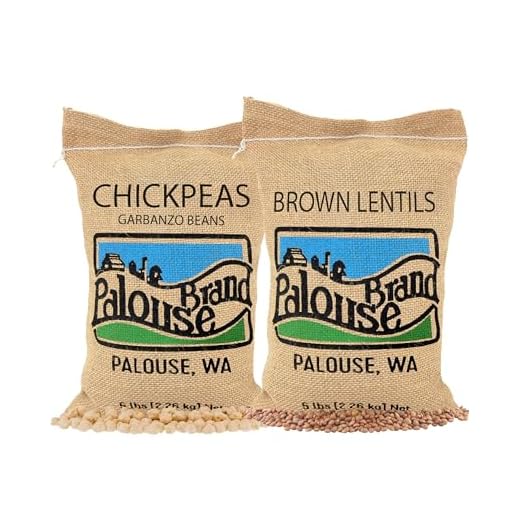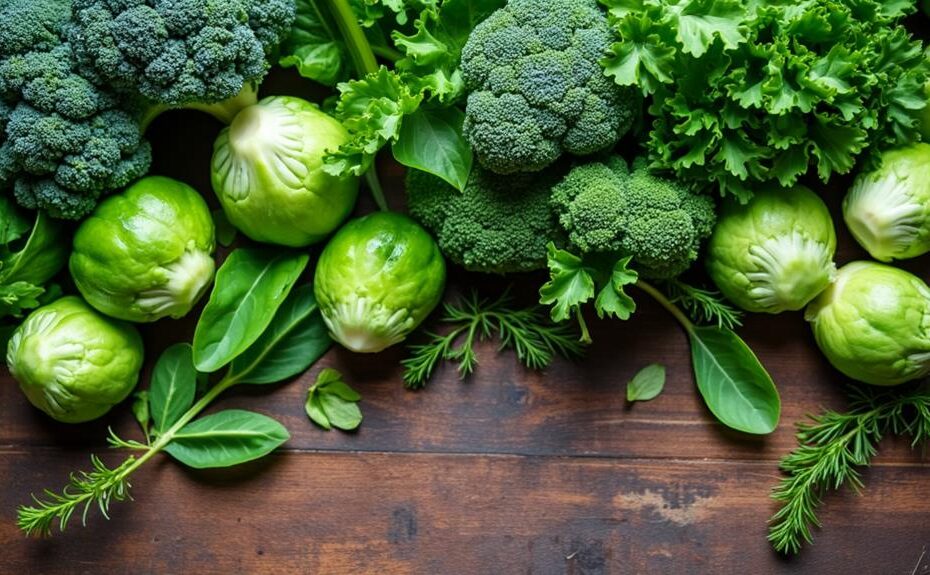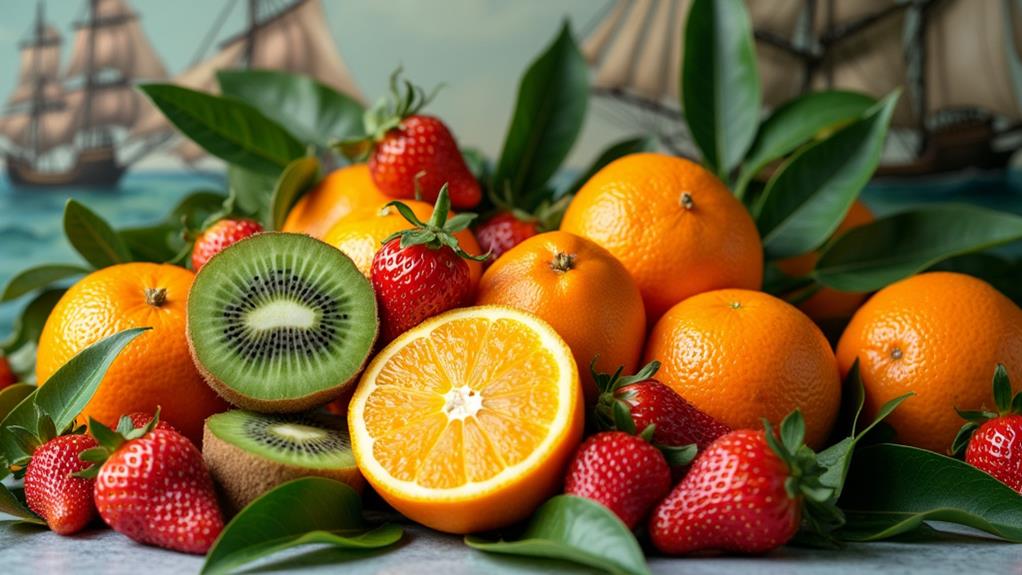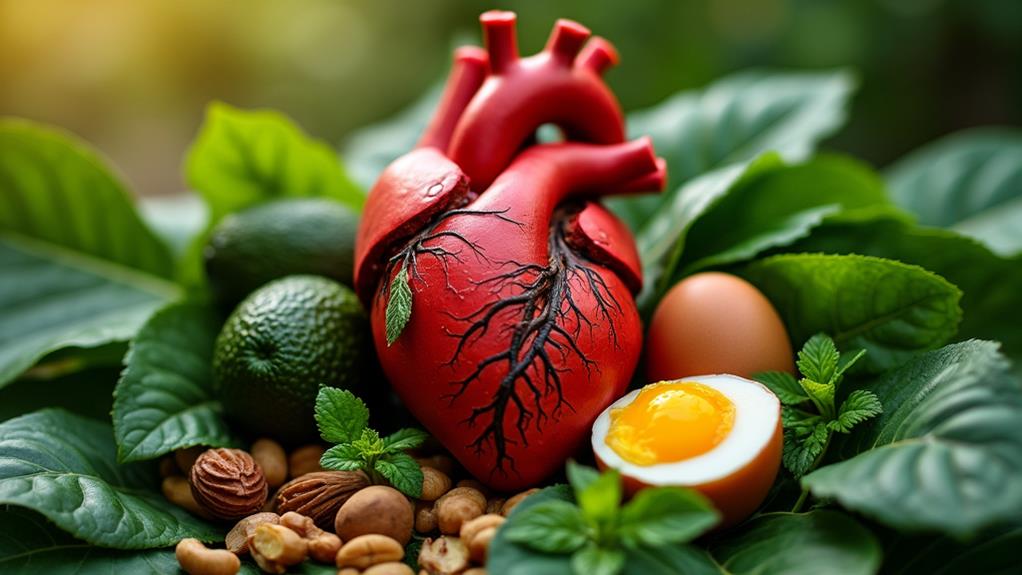







If you're looking to boost your vitamin K1 intake, dark leafy greens are your best bet. Foods like cooked kale, collard greens, and Swiss chard pack a powerful punch, offering well over the daily value per serving. Spinach and broccoli are great options too. Fruits like avocado and kiwi provide smaller amounts, while green peas and chickpeas are solid choices for legumes. Cooking these vegetables can enhance nutrient absorption, especially when combined with healthy fats. Understanding the benefits and sources of vitamin K1 is essential for your health, so keep exploring your options for a balanced diet.
Key Takeaways
- Dark leafy greens like collard greens and Swiss chard are the richest sources of Vitamin K1, providing over 500 mcg per serving.
- Cooked kale offers around 443% of the Daily Value for Vitamin K1 in just half a cup.
- Broccoli contains about 110 mcg of Vitamin K1 per half-cup when cooked, making it a nutritious option.
- Fruits such as kiwi and avocado provide moderate amounts of Vitamin K1, approximately 31 mcg and 20 mcg, respectively.
- Green peas and chickpeas are legumes that contribute to Vitamin K1 intake, with about 24 mcg and 6 mcg per half-cup cooked.
Importance of Vitamin K
Understanding the significance of vitamin K is fundamental for maintaining your overall health. This fat-soluble vitamin plays an essential role in blood clotting by supporting the synthesis of clotting factors in the liver. Without adequate vitamin K, you could face impaired blood clotting and increased bleeding, which can be dangerous. Additionally, both vitamins K1 and K2 regulate calcium in bones, enhancing bone mineralization and density, which is crucial for preventing osteoporosis and fractures functions and health benefits. Furthermore, vitamin K greatly contributes to bone health. It aids in the mineralization process, helping to reduce fracture risk and combat osteoporosis. The recommended daily intake of vitamin K is 90 mcg for women and 120 mcg for men, highlighting the need for regular consumption of vitamin K-rich foods.
While vitamin K1 is often the focus, it's noteworthy that vitamin K2 works synergistically with it, especially for cardiovascular health. Vitamin K2 prevents calcium buildup in arteries, promoting overall heart health. A deficiency in vitamin K can lead to weakened bone structure over time, making it essential to ascertain you're getting enough of this important nutrient.
Incorporating vitamin K-rich foods into your diet not only supports blood clotting and bone health but also contributes to your cardiovascular well-being.
Top Sources of Vitamin K1
To maintain ideal health, incorporating foods rich in vitamin K1 into your diet is crucial. Dark leafy greens are the richest sources of this essential nutrient. For instance, just 1/2 cup of cooked kale provides approximately 443% of the Daily Value (DV) for vitamin K1. Collard greens are another high source, offering about 530 mcg per 1/2 cup. Boiled turnip greens also contribute considerably, delivering around 426 mcg per 1/2 cup.
Spinach is a great addition as well, containing about 72.5 mcg of vitamin K1 per 3 oz when raw. Broccoli is another valuable vegetable, providing about 110 mcg of vitamin K1 per 1/2 cup when cooked. To enhance the absorption of dietary vitamin K, consider adding vegetable oils like soybean oil, which contains approximately 25 mcg of vitamin K1 per tablespoon.
Vegetables High in Vitamin K
Many vegetables are packed with vitamin K, making it easy to boost your intake through your diet. Dark leafy greens are the richest sources of vitamin K1. For instance, cooked kale provides an impressive 443% of the Daily Value (DV) in just half a cup. Spinach is another excellent source, offering about 181% of the DV per cooked half-cup serving. Collard greens deliver a substantial amount of vitamin K1, with approximately 530 mcg per half-cup when cooked.
Other notable vegetables high in vitamin K include Swiss chard, which contains around 573 mcg per half-cup, and broccoli, providing about 110 mcg per half-cup when cooked. To maximize the benefits of these vegetables, consider incorporating healthy fats, like olive oil, when you prepare them. This can enhance the absorption of vitamin K1 in your body.
Fruits With Vitamin K
While fruits aren't typically renowned for their vitamin K content, several varieties still offer valuable amounts that can help boost your intake. One standout option is avocado, which provides about 20 mcg of vitamin K1 per fruit. This creamy fruit not only enhances your meals but also contributes beneficial amounts of this essential nutrient.
Another great choice is kiwi, delivering approximately 31 mcg of vitamin K1 per 100 grams. Its sweet and tangy flavor makes it an enjoyable addition to your diet. Blueberries and grapes, while offering lower levels, still contribute to your overall dietary intake; blueberries contain around 19 mcg per cup, while grapes provide smaller amounts.
Figs are also worth mentioning, as they provide about 3 mcg of vitamin K1 per medium-sized fig. To make a noticeable impact on your vitamin K consumption, you'll want to enjoy figs in larger quantities. By incorporating these fruits into your meals and snacks, you can enhance your intake of foods containing vitamin K and support your overall health with delicious options.
Legumes and Nuts
Fruits provide a tasty way to increase your vitamin K intake, but legumes and nuts also play an important role in your diet. While they aren't the highest sources of vitamin K1, incorporating legumes like green peas, chickpeas, and lentils can still boost your dietary intake. For instance, a half-cup of cooked green peas offers about 24 mcg of vitamin K1, while chickpeas and lentils provide smaller amounts—around 6 mcg and 1.5 mcg, respectively.
Nuts, such as pine nuts and walnuts, contribute minor amounts of vitamin K1 as well, with roughly 1.2 mcg and 1.5 mcg per ounce. Although these figures may seem low compared to leafy greens, adding legumes and nuts to your meals enriches your overall nutritional profile. They not only help fulfill your vitamin K1 needs but also supply healthy fats and other essential nutrients.
Dairy and Meat Sources
When it comes to boosting your vitamin K intake, dairy and meat sources offer unique contributions, primarily in the form of vitamin K2. Dairy products, especially hard cheeses, are particularly rich in this nutrient, which is vital for bone and joint health. Incorporating these cheeses into your diet can enhance your overall vitamin K2 levels, which are important for bone health and cardiovascular function.
Meat sources also provide significant amounts of vitamin K2, with beef liver being among the richest options available. Including liver in your meals can substantially increase your vitamin K2 intake. Chicken and pork contribute to this intake as well, although the amounts depend largely on the animal's diet. For instance, grass-fed animals typically have higher levels of vitamin K2 due to their natural feeding habits.
While dairy and meat aren't primary sources of vitamin K1, they play an important role in complementing the benefits of K1 found in plant-based foods. It's important to pay attention to farming practices as they influence the vitamin content in these animal products. By choosing high-quality sources, you can maximize your vitamin K2 intake effectively.
Cooking Methods for Vitamin K
Cooking methods play an essential role in maximizing the benefits of vitamin K in your diet. When you cook leafy greens, it enhances their digestibility, making it easier for your body to absorb vitamin K. Steaming vegetables like kale and spinach is particularly effective, as this method retains more of their nutrient content compared to boiling. Additionally, incorporating Vitamin K1-rich foods into your meals promotes strong bones and supports overall skeletal well-being. While raw salads featuring dark leafy greens provide high levels of vitamin K1, cooking can increase the overall nutrient availability, even if it slightly reduces some vitamin levels.
To further boost your body's ability to absorb vitamin K, consider combining cooked greens with healthy fats, such as olive oil or butter. These fats greatly improve the absorption of vitamin K, making your meal even more beneficial.
Incorporating fermented foods like natto into your diet can also enhance your vitamin K intake, particularly vitamin K2. For ideal nutrient richness, focus on cooking methods that preserve the health benefits of plant sources. By choosing the right cooking techniques, you can guarantee that you're getting the most out of your vitamin K-rich foods.
Conclusion
Incorporating vitamin K1-rich foods into your diet is essential for maintaining healthy bones and supporting blood clotting. You might have heard that leafy greens are the best sources, and that's true—kale and spinach pack a powerful punch! However, don't overlook fruits, legumes, and even certain dairy products. By diversifying your meals, you not only boost your vitamin K1 intake but also enjoy a well-rounded diet. So, get creative in the kitchen and savor those nutrient-packed foods!



